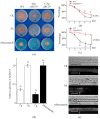Fusarium graminearum ATP-Binding Cassette Transporter Gene FgABCC9 Is Required for Its Transportation of Salicylic Acid, Fungicide Resistance, Mycelial Growth and Pathogenicity towards Wheat
- PMID: 30103374
- PMCID: PMC6121456
- DOI: 10.3390/ijms19082351
Fusarium graminearum ATP-Binding Cassette Transporter Gene FgABCC9 Is Required for Its Transportation of Salicylic Acid, Fungicide Resistance, Mycelial Growth and Pathogenicity towards Wheat
Abstract
ATP-binding cassette (ABC) transporters hydrolyze ATP to transport a wide range of substrates. Fusarium graminearum is a major causal agent of Fusarium head blight, which is a severe disease in wheat worldwide. FgABCC9 (FG05_07325) encodes an ABC-C (ABC transporter family C) transporter in F. graminearum, which was highly expressed during the infection in wheat and was up-regulated by the plant defense hormone salicylic acid (SA) and the fungicide tebuconazole. The predicted tertiary structure of the FgABCC9 protein was consistent with the schematic of the ABC exporter. Deletion of FgABCC9 resulted in decreased mycelial growth, increased sensitivity to SA and tebuconazole, reduced accumulation of deoxynivalenol (DON), and less pathogenicity towards wheat. Re-introduction of a functional FgABCC9 gene into ΔFgABCC9 recovered the phenotypes of the wild type strain. Transgenic expression of FgABCC9 in Arabidopsis thaliana increased the accumulation of SA in its leaves without activating SA signaling, which suggests that FgABCC9 functions as an SA exporter. Taken together, FgABCC9 encodes an ABC exporter, which is critical for fungal exportation of SA, response to tebuconazole, mycelial growth, and pathogenicity towards wheat.
Keywords: ABC transporter; Fusarium head blight; SA; mycotoxin.
Conflict of interest statement
The authors declare that there is no conflict of interest.
Figures





Similar articles
-
Major Facilitator Superfamily Transporter Gene FgMFS1 Is Essential for Fusarium graminearum to Deal with Salicylic Acid Stress and for Its Pathogenicity towards Wheat.Int J Mol Sci. 2021 Aug 7;22(16):8497. doi: 10.3390/ijms22168497. Int J Mol Sci. 2021. PMID: 34445203 Free PMC article.
-
Functional Analysis of FgNahG Clarifies the Contribution of Salicylic Acid to Wheat (Triticum aestivum) Resistance against Fusarium Head Blight.Toxins (Basel). 2019 Jan 22;11(2):59. doi: 10.3390/toxins11020059. Toxins (Basel). 2019. PMID: 30678154 Free PMC article.
-
Effect of salicylic acid on Fusarium graminearum, the major causal agent of fusarium head blight in wheat.Fungal Biol. 2012 Mar;116(3):413-26. doi: 10.1016/j.funbio.2012.01.001. Epub 2012 Jan 16. Fungal Biol. 2012. PMID: 22385623
-
Linoleic acid isomerase gene FgLAI12 affects sensitivity to salicylic acid, mycelial growth and virulence of Fusarium graminearum.Sci Rep. 2017 Apr 7;7:46129. doi: 10.1038/srep46129. Sci Rep. 2017. PMID: 28387243 Free PMC article.
-
Salicylic acid regulates basal resistance to Fusarium head blight in wheat.Mol Plant Microbe Interact. 2012 Mar;25(3):431-9. doi: 10.1094/MPMI-09-11-0232. Mol Plant Microbe Interact. 2012. PMID: 22112217
Cited by
-
FgCWM1 modulates TaNDUFA9 to inhibit SA synthesis and reduce FHB resistance in wheat.BMC Biol. 2024 Sep 11;22(1):204. doi: 10.1186/s12915-024-02007-8. BMC Biol. 2024. PMID: 39256758 Free PMC article.
-
Effect of Baicalin-Aluminum Complexes on Fecal Microbiome in Piglets.Int J Mol Sci. 2019 May 14;20(10):2390. doi: 10.3390/ijms20102390. Int J Mol Sci. 2019. PMID: 31091773 Free PMC article.
-
Major Facilitator Superfamily Transporter Gene FgMFS1 Is Essential for Fusarium graminearum to Deal with Salicylic Acid Stress and for Its Pathogenicity towards Wheat.Int J Mol Sci. 2021 Aug 7;22(16):8497. doi: 10.3390/ijms22168497. Int J Mol Sci. 2021. PMID: 34445203 Free PMC article.
-
Histone H3 N-Terminal Lysine Acetylation Governs Fungal Growth, Conidiation, and Pathogenicity through Regulating Gene Expression in Fusarium pseudograminearum.J Fungi (Basel). 2024 May 25;10(6):379. doi: 10.3390/jof10060379. J Fungi (Basel). 2024. PMID: 38921366 Free PMC article.
-
Fusarium graminearum FgCWM1 Encodes a Cell Wall Mannoprotein Conferring Sensitivity to Salicylic Acid and Virulence to Wheat.Toxins (Basel). 2019 Oct 29;11(11):628. doi: 10.3390/toxins11110628. Toxins (Basel). 2019. PMID: 31671876 Free PMC article.
References
-
- Chandler E.A., SimPson D.R., Thomsett M.A., Nicholson P. Development of PCR assays to Tri7 and Tri13 trichothecene biosynthetic genes, and characterization of chemotypes of Fusarium graminearum, Fusarium culomrum and Fusarium cerealis. Physiol. Mol. Plant Pathol. 2003;62:355–367. doi: 10.1016/S0885-5765(03)00092-4. - DOI
MeSH terms
Substances
LinkOut - more resources
Full Text Sources
Other Literature Sources

